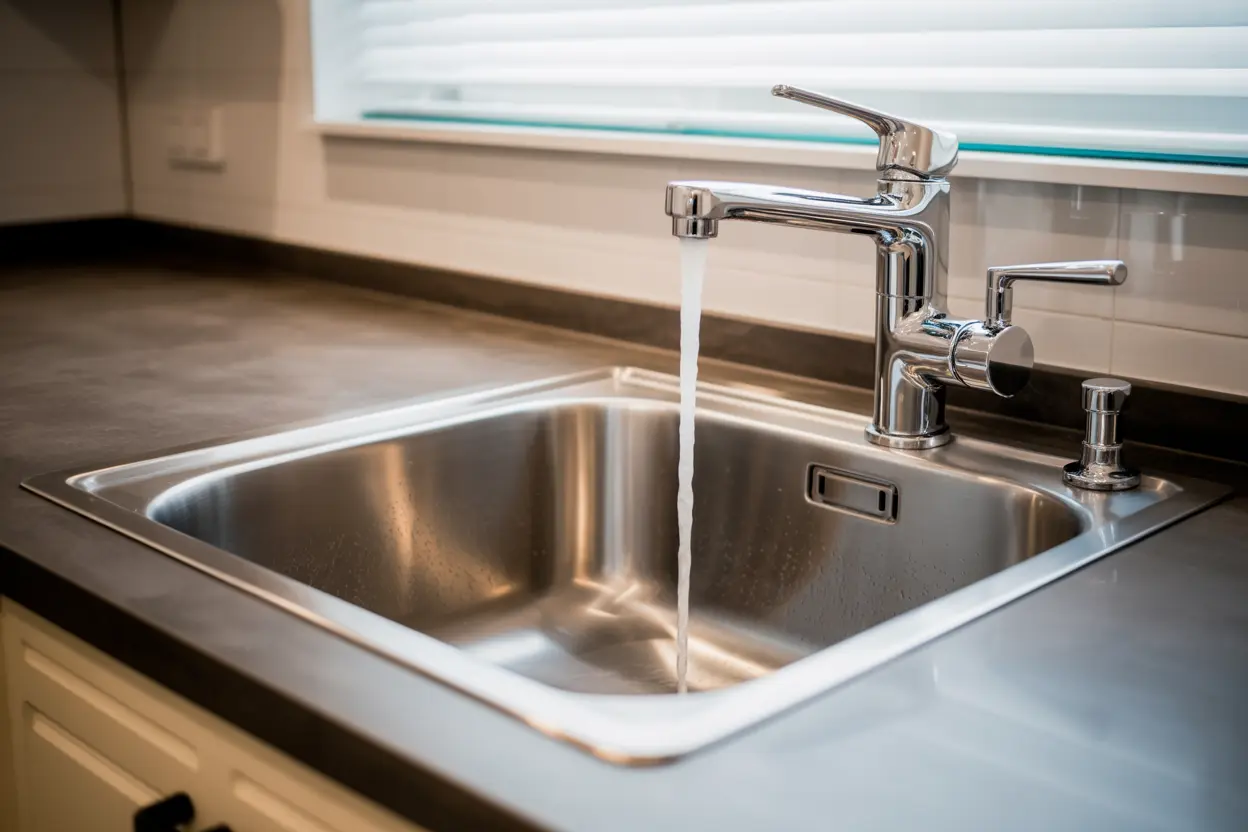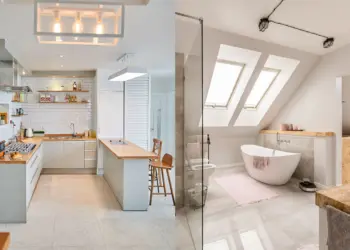An essential element of the kitchen, the sink must be functional, resistant and aesthetic. Single or double bowl, resin, stainless steel or stone, the sink must be perfectly integrated into the design of the kitchen while being practical. To help you choose the right kitchen sink for your needs, follow the guide!
Choosing a kitchen sink can be an important decision, as it is a functional and aesthetic element in your kitchen that you’ll likely use every day. Here are some tips on how to choose the right kitchen sink for your needs:
Table of Contents
The first criteria to consider when choosing a kitchen sink
The first thing to consider when choosing a sink is the kitchen configuration: are you replacing your old sink on an existing cabinet or installing a sink for your new kitchen?
Kitchen sink renovation:
When renovating, you’ll be forced to find a sink that fits over your existing vanity or countertop. Fortunately, there are so many different sizes of sinks that you are bound to find something that fits! All you have to do is choose the material. If your renovation means that you have no constraints, then you will choose it as if it were new. The important thing to consider is the depth of the bin(s) (especially if you have drawers, cabinets, or appliances underneath)! Also, consider the size of your faucet.
Kitchen Sink: new installation
If you are looking for a sink for your new kitchen, you will need to choose:
- The dimensions, to fit the worktop;
- The shape, to be adapted to your tastes and space;
- The number of bowls and their depth;
- The presence of a drainer or not;
- The material, combined with aesthetics and maintenance.
If you don’t have any space constraints, you’ll usually choose a two-bowl sink with a drainer combined with a mixer tap, with a retractable hand shower – the best for washing up! If you don’t have much space, a single-bowl sink with a drainer is a good compromise. Coupled with a high kitchen faucet, the installation is perfect. Most kitchenettes are equipped with a small aluminum sink with a mini drainer. It is not the greatest luxury but for the available surface it is the best. The material has an impact on the aesthetics and the maintenance:
- Stoneware and ceramics are robust and heavy and the maintenance is the least restrictive;
- Stone is the heaviest and the most demanding maintenance;
- Resin is lighter and requires more careful maintenance;
- Aluminum is light and easy to maintain.
As for the type of installation, to be placed (basin type), to be embedded (lip on the top of the worktop), to be integrated or embedded underneath (flush sink, the easiest to clean but more technical to install), it is a question of style and practicality.
Kitchen sink: maintenance and accessories
Also think about maintenance. Your future sink will be used a lot, you will store dirty dishes, wash your hands, rinse fruits and vegetables… Choose a sink that is easy to clean (the best quality/price ratio is stainless steel, then resin). Also think about the sink accessories that will make your life easier: drainer, filters or plugs, overflow, etc.
Kitchen Sink Materials
When choosing a kitchen sink, the material is an important consideration as it affects the sink’s durability, maintenance requirements, appearance, and functionality. Here are some common kitchen sink materials and their characteristics:
Stainless Steel:
Stainless steel is a popular choice for kitchen sinks due to its durability, affordability, and versatility. Stainless steel sinks are resistant to staining, chipping, and heat, and they are easy to clean. They come in various finishes, such as brushed or polished, and can complement a wide range of kitchen styles. However, they can show water spots and scratches over time, and lower-gauge stainless steel sinks may be more susceptible to denting.
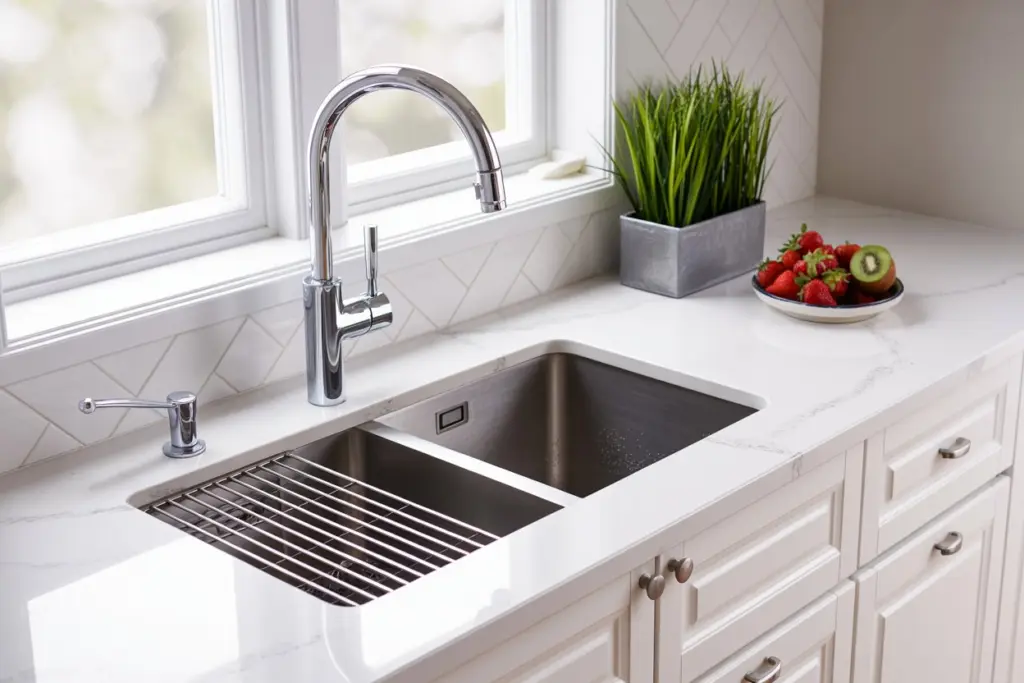
Porcelain/Enamel:
We know porcelain or enamel sinks for their classic, glossy appearance and often used in traditional or vintage-style kitchens. They are resistant to heat, staining, and fading, and they are easy to clean. However, porcelain sinks can be more delicate and prone to chipping or cracking compared to other materials, and you should avoid abrasive cleaners or sharp objects to prevent damage to the enamel.
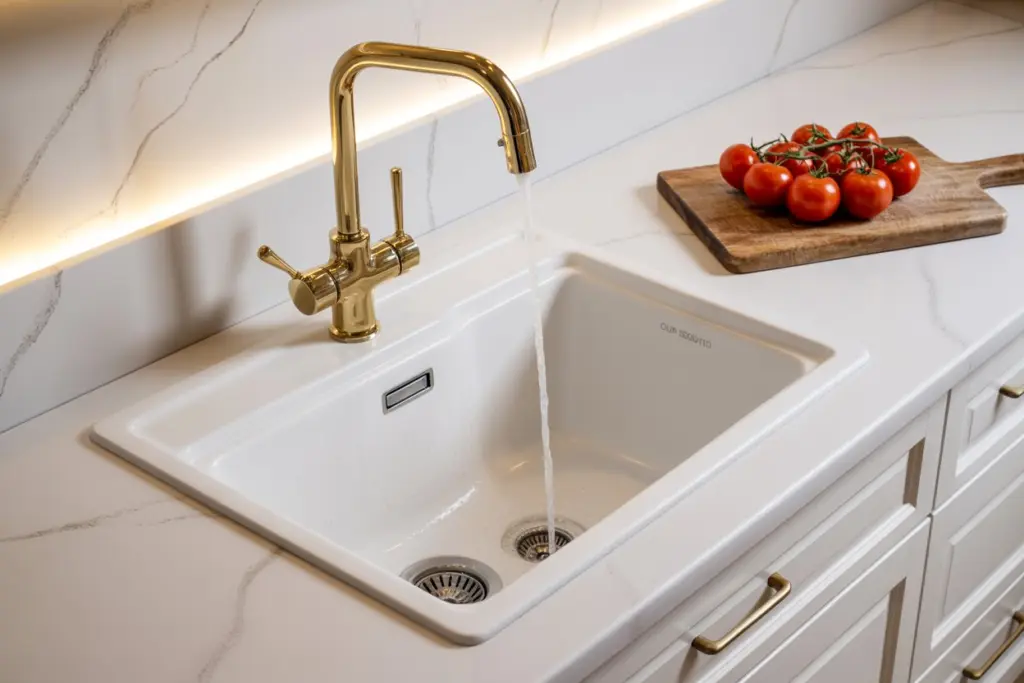
Cast Iron:
Known for their durability and classic look. Also coated with enamel, which provides a smooth and glossy finish that is resistant to staining, scratching, and heat. Cast iron sinks are heavy and may require additional support during installation. They can also be more expensive compared to other materials, and if subject to heavy impact or dropped objects, the enamel coating can chip.

Granite Composite:
Granite composite sinks made from a mixture of granite or quartz particles and resin, resulting in a durable and heat-resistant material that is resistant to staining, chipping, and scratching. Granite composite sinks often come in a range of colors and finishes, and they can add a modern, sleek look to your kitchen. However, they may require special care and cleaning to maintain their appearance, and they can be more expensive than other materials.
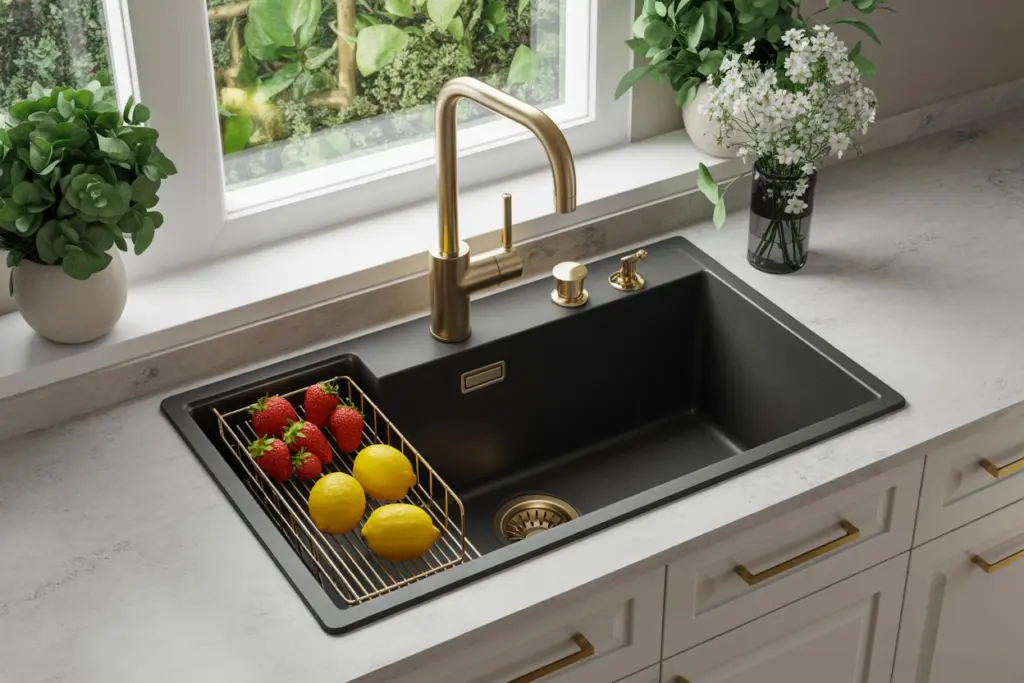
Fireclay:
Fireclay sinks made from clay that fired at a high temperature, resulting in a durable and heavy material that is resistant to staining, chipping, and scratching. Fireclay sinks have a glossy, porcelain-like finish and known for their farmhouse or apron-front style that adds a rustic charm to your kitchen. However, fireclay sinks can be more expensive and may require special care and cleaning to prevent chipping or cracking.

Solid Surface:
Solid surface sinks made from a composite material that combines acrylic or polyester resins with mineral fillers, resulting in a non-porous and durable material that is resistant to staining, chipping, and scratching. Solid surface sinks are available in various colors and styles, and they can integrated seamlessly with the countertop for a sleek, modern look. However, solid surface sinks can be more expensive and may require careful maintenance to prevent damage.

The main types of kitchen sinks
There are several types of kitchen sinks to choose from, each with its own installation method and style. Here are some common types of kitchen sinks:
Undermount kitchen Sink:
An undermount sink installed underneath the countertop, with the edges of the sink hidden beneath the countertop surface. This type of sink provides a clean and seamless look, as there is no rim or lip visible on the countertop. Undermount sinks are typically compatible with solid surface or stone countertops, such as granite or quartz, and they offer easy countertop cleanup as there are no edges to catch debris. However, they may require professional installation and are generally more expensive compared to other types of sinks.
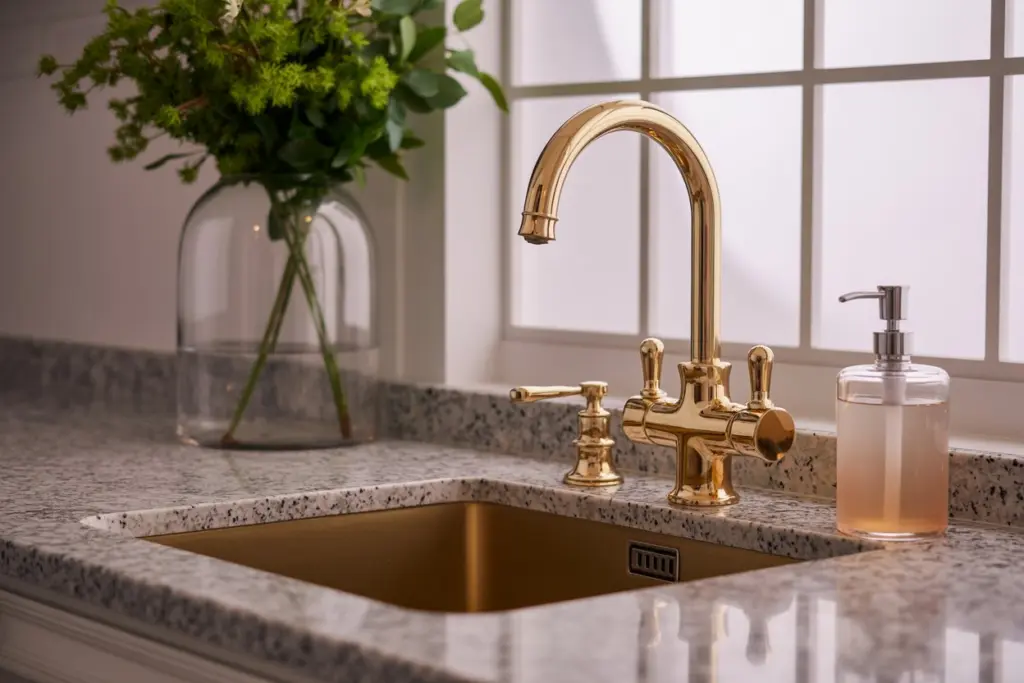
Top-Mount kitchen Sink:
Also known as a drop-in or self-rimming sink, a top-mount sink is installed on top of the countertop, with the edges of the sink resting on the countertop surface. The rim or lip of the sink is visible on the countertop, creating a distinctive look. Top-mount sinks are relatively easy to install and are compatible with a wide range of countertop materials. They also tend to be more affordable compared to undermount sinks. However, the exposed rim may make cleaning the countertop more challenging as debris can accumulate around the edges.
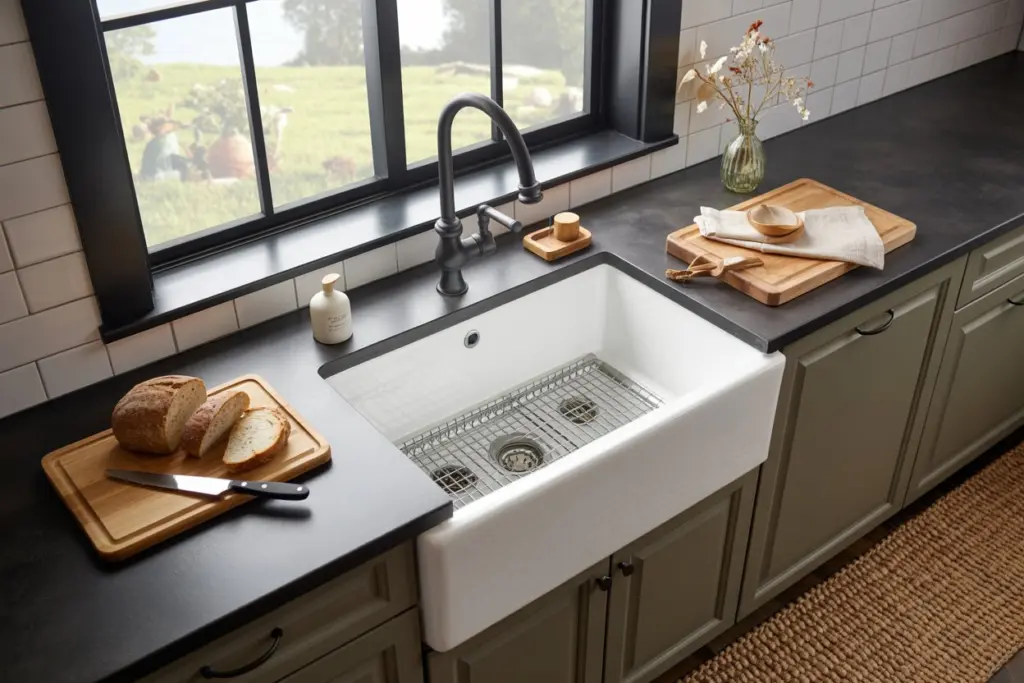
Farmhouse kitchen Sink:
Also known as an apron-front sink, a farmhouse sink has a large, exposed front panel that extends beyond the edge of the countertop. Farmhouse sinks known for their rustic and charming appearance, and they can be a focal point in a kitchen design. They are typically installed as an undermount sink, and their deep bowls provide ample space for washing large pots and pans. Farmhouse sinks are available in various materials, such as porcelain, stainless steel, or fireclay, and they can add a unique and stylish element to your kitchen. However, farmhouse sinks may require special installation considerations and are generally more expensive compared to other types of sinks.
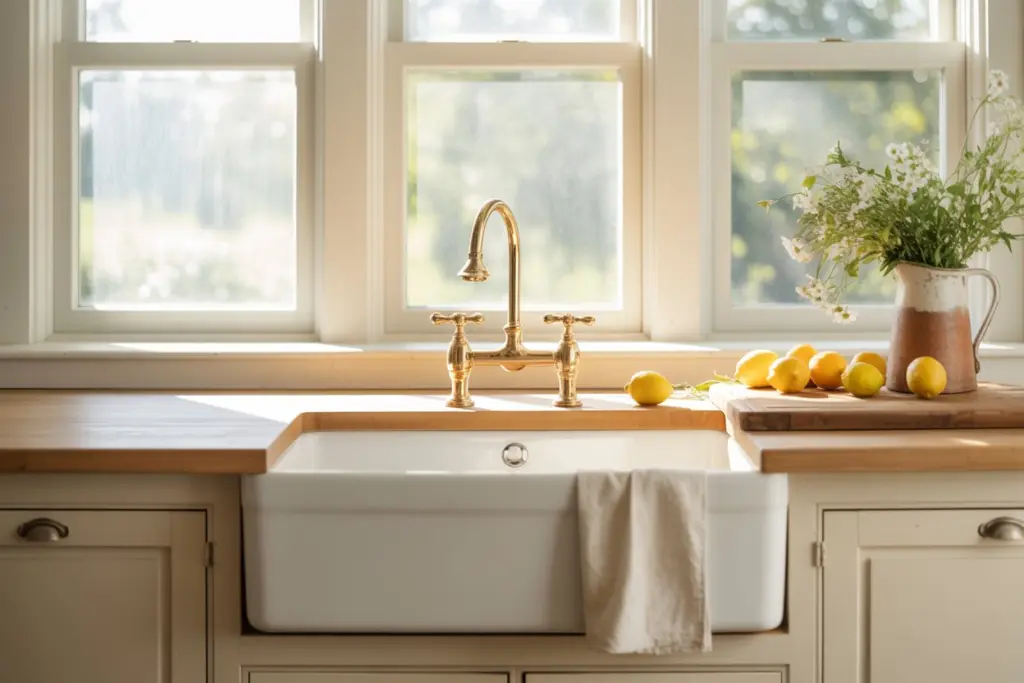
Integrated kitchen Sink:
An integrated sink, also known as a molded or integral sink, made from the same material as the countertop and seamlessly integrated into the countertop surface. Integrated sinks provide a sleek and seamless look, as there are no edges or rims visible, and they are easy to clean. They are typically found in solid surface or stone countertops, such as quartz or granite, and offer a modern and minimalist aesthetic. However, integrated sinks may have limited options in terms of size, shape, and material, and they may require professional installation.
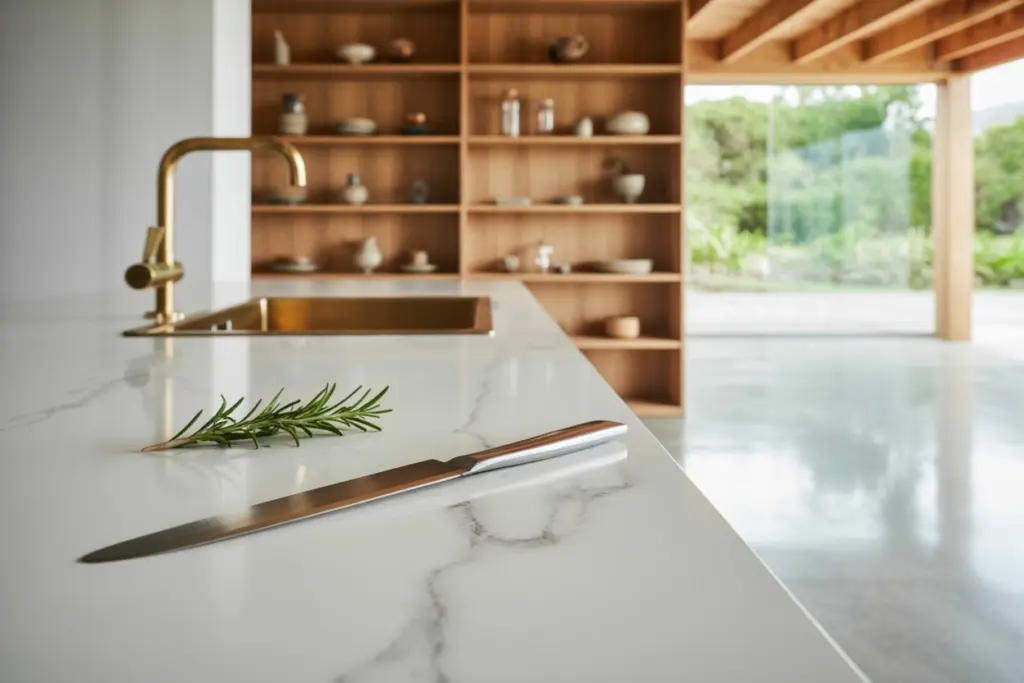
Bar/Prep kitchen Sink:
Bar or prep sinks are smaller sinks typically used for secondary prep areas, wet bars, or as additional sinks in kitchen islands. They come in various styles and materials, and they can be either top-mount or undermount sinks. Bar or prep sinks are convenient for food preparation, entertaining, or washing smaller items, and they can add functionality and versatility to your kitchen layout.

Size of kitchen sinks
The size of a kitchen sink is an important consideration to ensure it fits well within your kitchen space and meets your functional needs. Here are some key points to keep in mind when determining the size of your kitchen sink:
Cabinet Size:
Measure the width and depth of the cabinet where you will install the sink. The sink should fit comfortably within the cabinet width, leaving enough space for the sink to be mounted and for any additional accessories, such as a faucet and soap dispenser, to install.
Bowl Size:
Consider the size of the bowl(s) in the sink in relation to your cooking and cleaning needs. A larger bowl will provide more space for washing larger pots and pans, while a smaller bowl may be suitable for smaller kitchens or as a secondary sink. Also, consider the depth of the bowl, as deeper bowls can hold more dishes and reduce splashing, but may require more bending for use.
Overall Sink Size:
The overall size of the sink should be proportionate to your countertop and backsplash. It should not overwhelm the countertop space or obstruct any adjacent features, such as windows or outlets. Also, consider the sink’s height in relation to your countertop, as it should be at a comfortable height for ease of use.
Clearance Requirements:
Take into account any clearance requirements for the sink, such as the distance from the sink to the backsplash or the edge of the countertop. These clearances may vary depending on the sink installation method (e.g., top-mount, undermount) and the type of countertop material (e.g., laminate, stone).
Consider Workflow:
Think about your kitchen workflow and how the sink size can enhance your daily tasks. If you do a lot of cooking and cleaning, a larger sink may be more suitable for washing larger cookware and facilitating food prep. If you have a small kitchen or limited counter space, a smaller sink may be more practical.
Faucet Placement:
Consider the placement of the faucet in relation to the sink size. The faucet should be positioned in a way that allows for easy access to the sink bowls and doesn’t obstruct the use of the sink.
Codes and Regulations:
Be aware of any local building codes or regulations that may specify minimum requirements for sink size in your area. These codes may vary depending on the location and intended use of the sink.
The different existing configurations
Once you have chosen the type of sink to install in your kitchen, you need to choose its configuration: single sink, single sink with drainer, double sink, etc.
Sink single bowl
The single bowl sink is perfect if you are limited in space or if you only use your kitchen occasionally (outdoor kitchen). The single bowl sink is also a good choice if you have a dishwasher. Even smaller, the half bowl sink fits in the smallest kitchens.
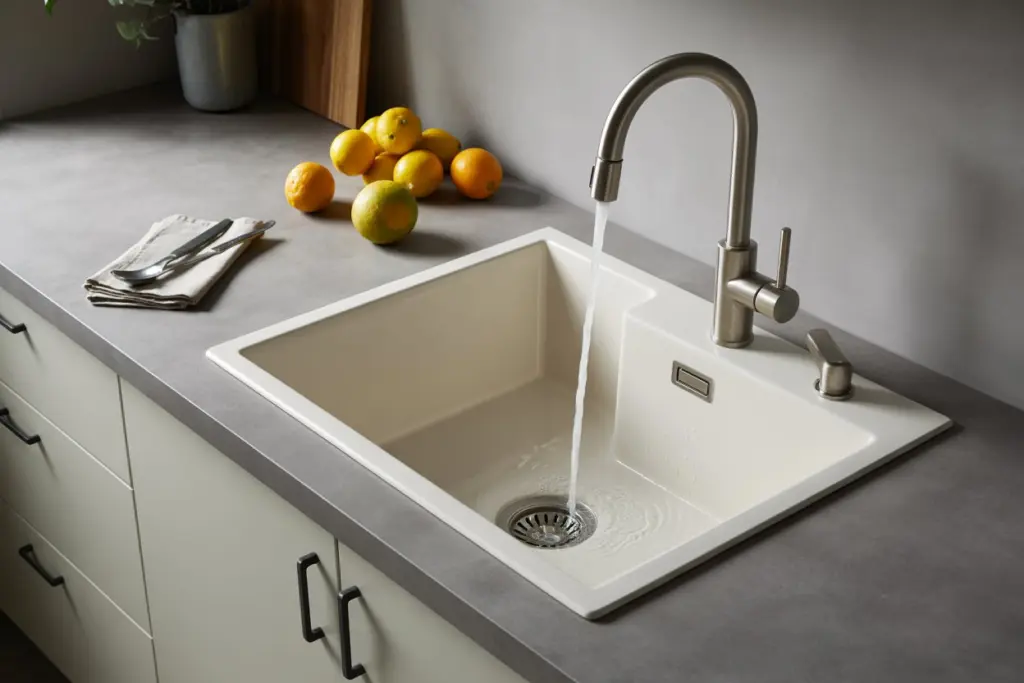
Single sink with drainer
The single bowl sink with drainer is ideal for a small kitchen that does not have a dishwasher. However, its volume is limited, which makes it suitable for one or two people maximum.
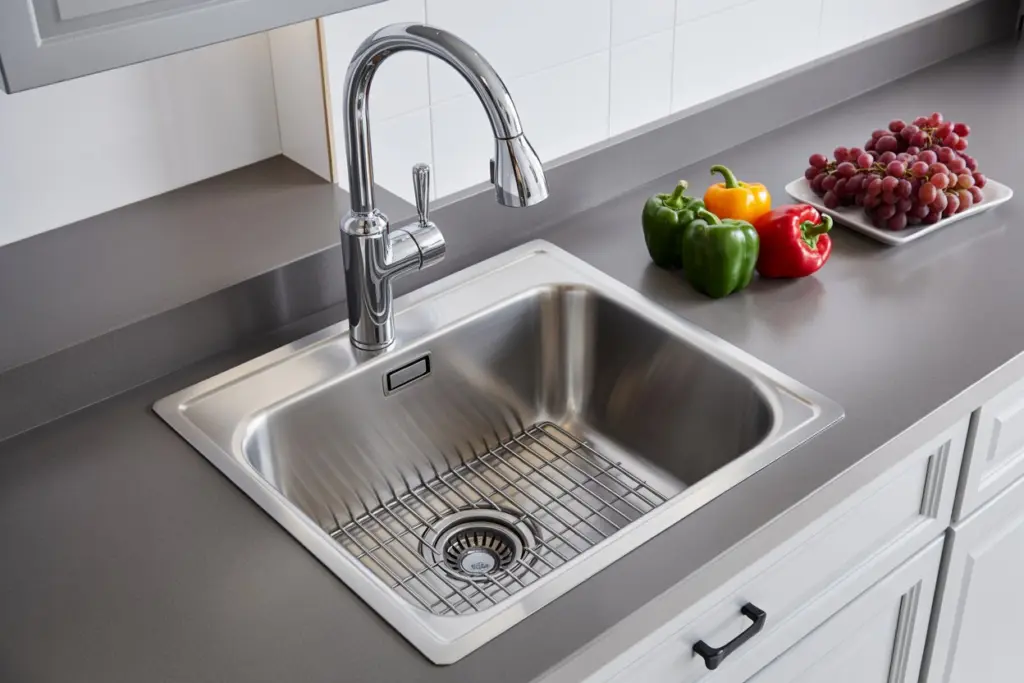
1 and a half sink with drainer
The one and a half sink with drainer is the compromise between the single sink and the double sink. Very practical to wash fruits and vegetables on one side while storing dirty dishes on the other. This type of sink is a good compromise for a small kitchen!
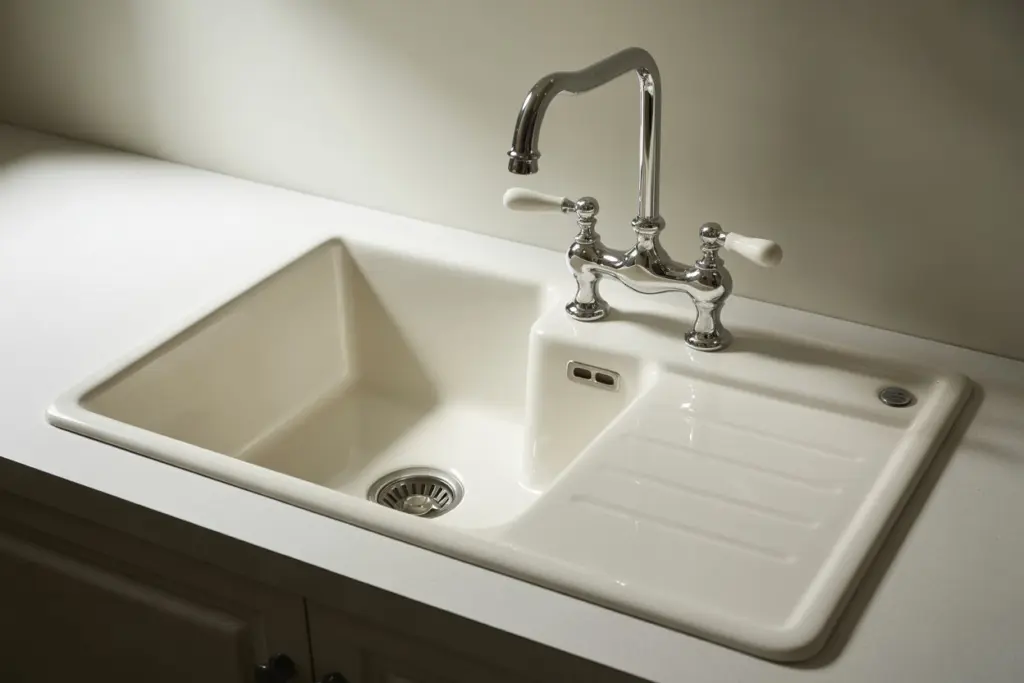
Double sink with drainer
The double sink with drainer is the most common model because it is the most practical. Whether or not you have a dishwasher, whether or not there are many people at home… the double sink with drainer is the most functional configuration.
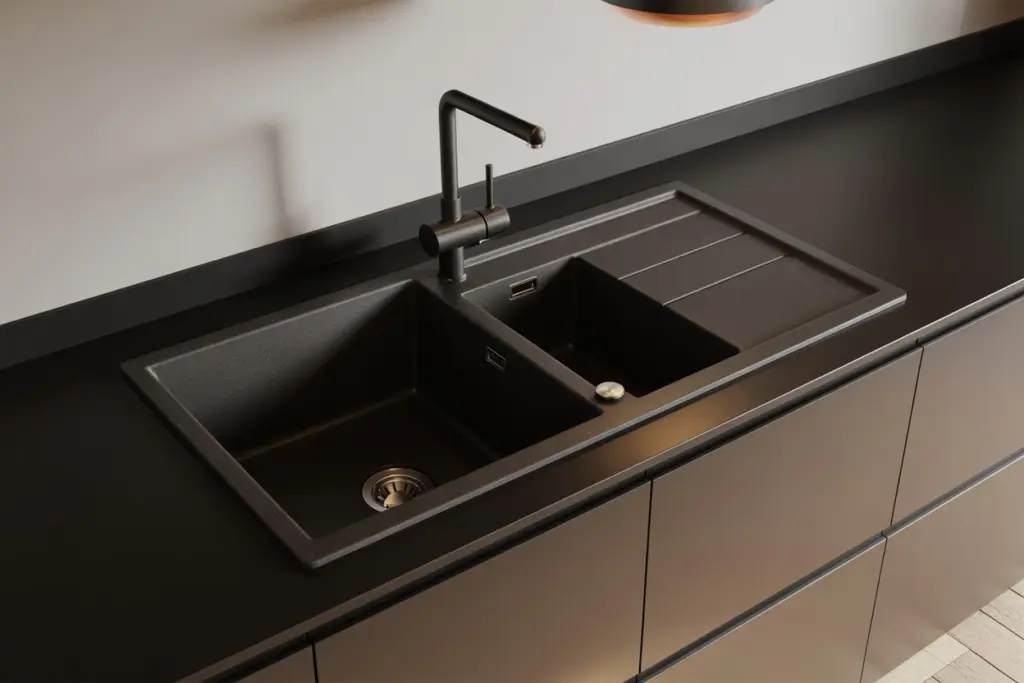
Sink with more than 2 bowls with or without drainer
Quite rare and therefore relatively expensive, this type of sink reserved for very specific uses (communities, restaurants, etc.) or for large families with a large kitchen.
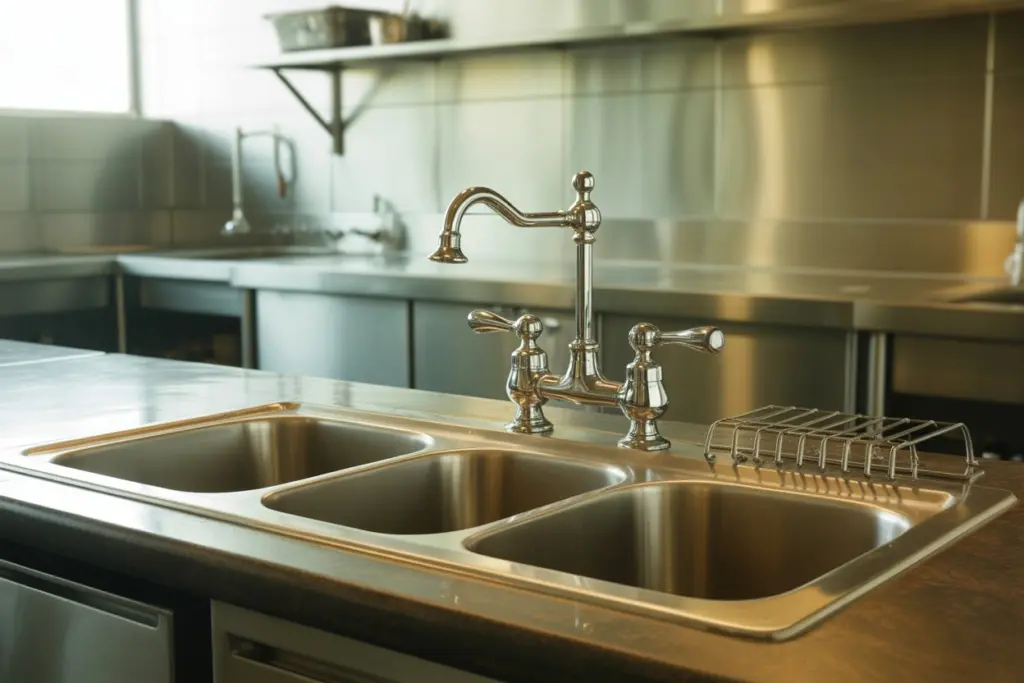
The most common kitchen sink shapes
Square kitchen sink
This is the shape most found on single bowl sinks. Very compact, the square sink is ideal for optimizing space; it combined with a drainer.

Round kitchen sink
Single or double, the round sink is generally used for cleaning fruits and vegetables because its shape is not very suitable for washing dishes (that’s why we rarely find a round sink with a drainer). The round sink is difficult to optimize the available space.
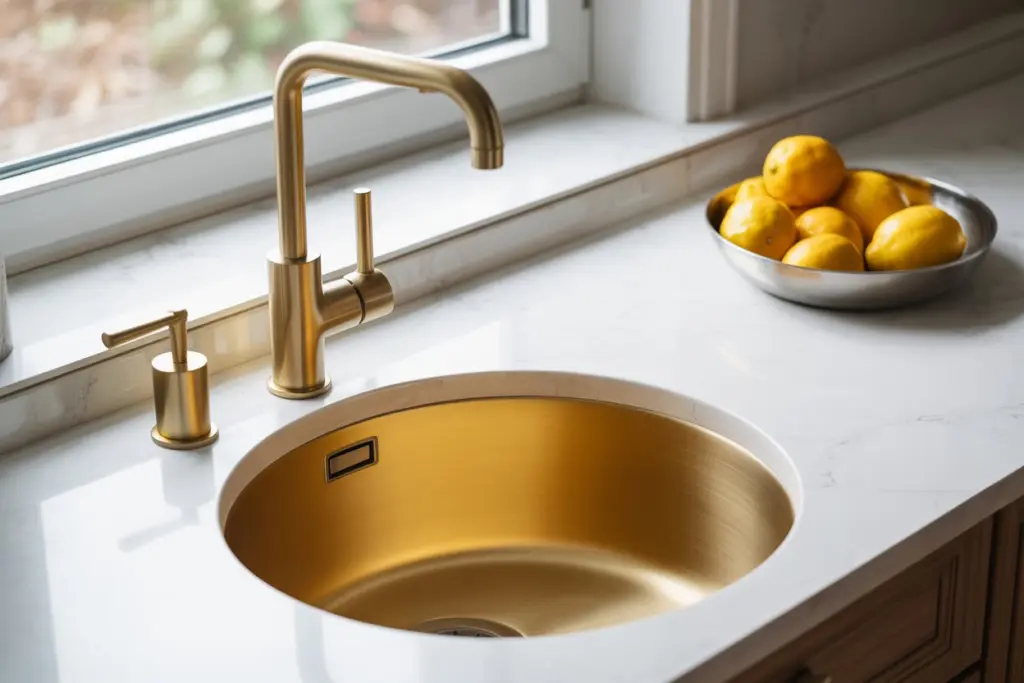
Rectangular kitchen sink
The most classic and practical shape. The rectangular sink is ideal for washing dishes, cleaning fruits and vegetables, filling buckets and for all other household tasks. Available in virtually any size, the rectangular sink fits any kitchen configuration.
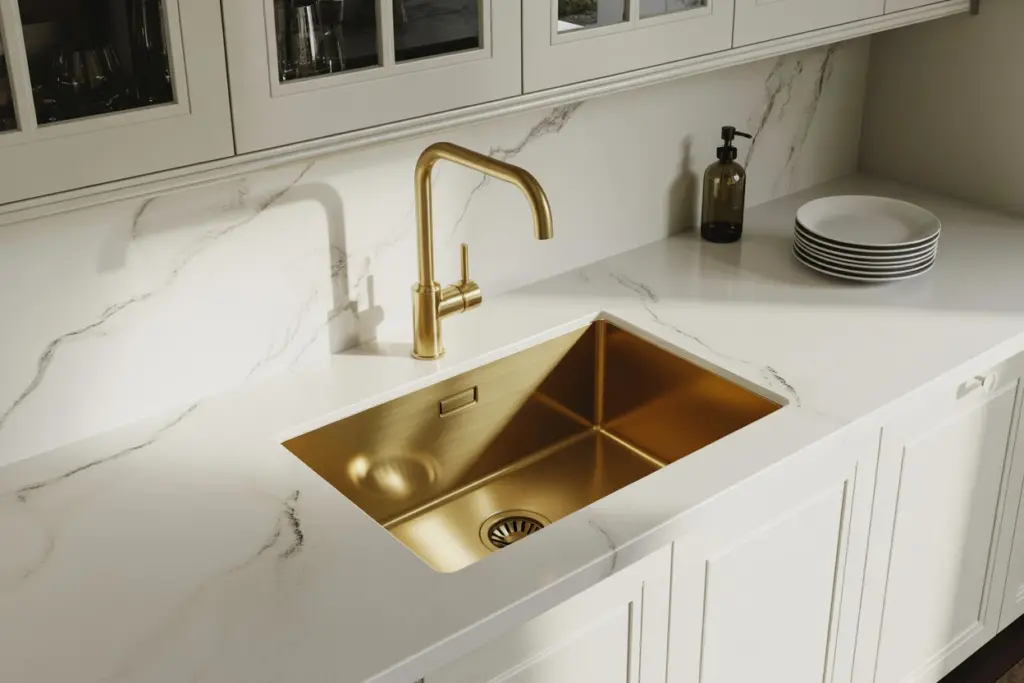
Corner sink
The corner sink allows you to optimize space on a work surface that has a corner (which often represents unused or lost space).

How much does a kitchen sink cost?
The cost of a kitchen sink can vary greatly depending on factors such as the material, type, size, brand, and design. Here is a general overview of the budget and price ranges for kitchen sinks:
Budget-Friendly (Under $100): You can find basic kitchen sinks made of materials like stainless steel, acrylic, or composite for under $100. These sinks are usually smaller, may have limited features, and are typically top-mounted or drop-in sinks. They may be suitable for budget-conscious buyers or for smaller kitchens with basic needs.
Mid-Range ($100 – $500): Most kitchen sinks fall into this price range. You can find a wide variety of materials, sizes, types, and designs within this price range. Stainless steel, fireclay, granite composite, and cast iron sinks are commonly available in this price range. These sinks may have additional features such as multiple bowls, soundproofing, and better durability. Both top-mount and undermount sinks are available in this price range, offering more options for customization.
High-End ($500 and above): High-end kitchen sinks are typically made of premium materials such as high-quality stainless steel, copper, or natural stone, and may have luxurious designs and features. These sinks may also be larger and designed for specific styles or custom installations. High-end sinks can exceed $1,000 or more, depending on the material, brand, and design.
It’s important to note that in addition to the cost of the sink itself, you may also need to consider the cost of installation, including plumbing and any additional accessories or modifications required, such as faucets, drains, and sink grids.
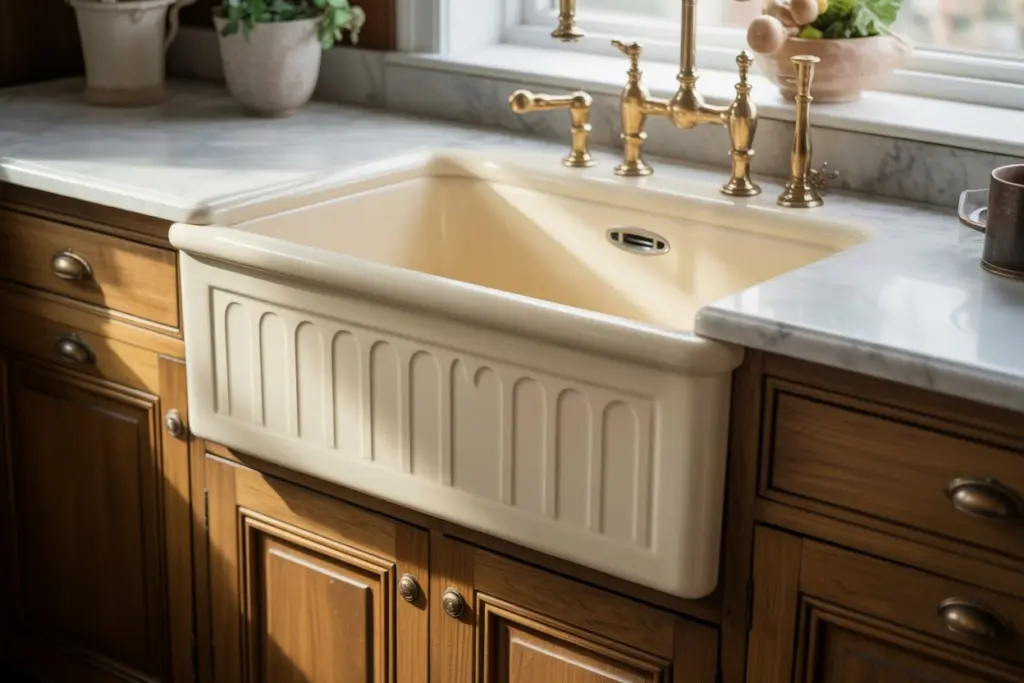
Which kitchen sink for which decoration styles?
The choice of kitchen sink can complement the overall aesthetic of your kitchen and enhance the visual appeal of your space. Here are some suggestions for different kitchen sink styles that can work well with various decoration styles:
Traditional or Classic Style:
For a traditional or classic kitchen decoration style, a farmhouse sink or an apron front sink can be an excellent choice. These sinks have a timeless, rustic look with a large, deep basin and a front-facing apron that adds character to the kitchen. Farmhouse sinks are typically made of fireclay, porcelain, or stainless steel, and can blend well with traditional cabinetry, natural wood tones, and warm color palettes.
Modern or Contemporary Style:
Stainless steel sink or a composite granite sink can be a sleek and stylish choice. Stainless steel sinks known for their clean lines, minimalist design, and durability, making them a popular choice for modern kitchens. Composite granite sinks, with their solid and seamless appearance, can also complement contemporary kitchen designs with their sleek, matte finish and variety of color options.
Transitional Style:
Transitional kitchen styles blend elements of traditional and modern designs, and a stainless steel sink or a quartz sink can be a good fit for this style. Stainless steel sinks can provide a transitional look with their clean lines and versatility, while quartz sinks offer a mix of modern and classic aesthetics with their durable and sleek appearance.
Rustic or Country Style:
For a rustic or country kitchen decoration style, a copper sink or a stone sink can be a great choice. Copper sinks known for their warm and rustic appearance, with their unique patina and natural variations in color. Stone sinks, such as granite or soapstone, can also add a rustic touch with their natural and textured surface, providing an earthy and organic look to the kitchen.
Industrial Style:
Industrial kitchen styles often feature exposed metal, raw materials, and a utilitarian look. A stainless steel sink or a concrete sink can complement this style well. Stainless steel sinks with their sleek and durable design can provide a clean and industrial look, while concrete sinks can add an edgy and modern aesthetic with their unique texture and industrial-inspired appearance.
Coastal or Beach Style:
A porcelain or enamel sink in a light color can work well. Porcelain or enamel sinks with their glossy finish and clean lines can provide a fresh and airy look, reminiscent of a beach house or coastal cottage.
